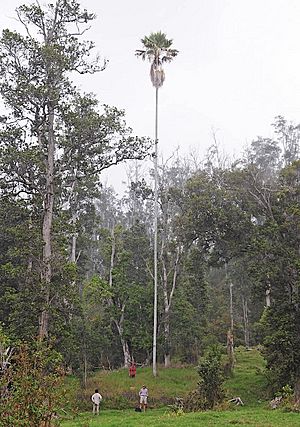Lands of papa pritchardia facts for kids
Quick facts for kids Lands of papa pritchardia |
|
|---|---|
 |
|
| Conservation status | |
| Scientific classification | |
| Genus: |
Pritchardia
|
| Species: |
schattaueri
|
The Pritchardia schattaueri, also known as the lands of papa pritchardia or Schattauer's loulu, is a type of palm tree. It grows only in the mixed forests on the southwest side of the island of Hawaiʻi, near Kona. This special palm is officially listed as a critically endangered species, meaning it's very close to disappearing forever.
Contents
About This Amazing Palm Tree
This palm tree can grow incredibly tall, reaching up to 40 meters (about 130 feet)! Its trunk is smooth and grayish, and can be up to 30 centimeters (12 inches) wide. At the top, it has a large, round crown with up to 30 leaves that spread out or hang down.
The leaves are huge, about 1.5 meters (5 feet) long and 1.8 meters (6 feet) wide. They have slightly wavy edges and are attached to stems called petioles, which can be 1.8 meters (6 feet) or longer. The leaves are shiny green on both sides and are divided into many parts with tips that hang down.
This palm produces flowers in clusters called inflorescences. These clusters are usually shorter than the leaf stems. After the flowers, large, shiny, black, round fruits grow. They are about 5 centimeters (2 inches) long when they are ripe. This palm grows in areas that get about 2000 millimeters (79 inches) of rain each year.
Where This Palm Lives
Today, there are only about twelve of these special Pritchardia schattaueri palms left in the wild. They live in moist forests on the island of Hawaiʻi, in a place called South Kona. This area is about 600 to 790 meters (2,000 to 2,600 feet) above sea level.
Ten of these palms are found close together on a cattle ranch, among tall ōhiʻa trees. The other two are a bit further away. One is in a macadamia nut farm, and the other is in a small patch of forest that hasn't been cleared.
A Bit of History
The Pritchardia schattaueri palm was officially named and described in 1985 by a scientist named Donald Hodel. He based his description on a sample collected in 1980. The palm was named after George Schattauer.
George Schattauer was the manager of Ho'omau ranch. He discovered these palms in 1960 while clearing land for farming. George loved Hawaiian plants and wanted to protect them. He understood how important his discovery was, so he left the palms standing. Later, he sent their fruits to the Honolulu Botanical Gardens, where new palms were grown. These palms are now officially recognized as "Exceptional Trees of Hawaiʻi."
How People Used This Palm
Long ago, the native Hawaiians valued the fruits of Pritchardia palms as food. They would gather the young fruits, called hāwane or wāhane, and eat the inside, which tasted like coconut meat.
The leaves were also very useful. People used them to make roofs for their homes, as well as fans, umbrellas, hats, and baskets. The strong trunks of the palms were used to make spears and for building things.
Today, Pritchardia palms from Hawaii are popular with plant growers in places with warm climates. This includes areas like southern California, southern Europe, and southern Australia. They are liked because they can handle cooler temperatures better than some other Pritchardia palms from the South Pacific.
Saving the Pritchardia schattaueri
The Pritchardia schattaueri palm is a critically endangered species. This means it's at a very high risk of becoming extinct. There are only 12 of these palms left in the wild, and they are all on private land.
Many things threaten these palms. These include cities growing larger, their natural homes being destroyed, and damage from animals like rats, pigs, and cattle. Weeds also cause problems. Because there are so few palms left, it's hard for new ones to grow naturally.
Their small number and limited area make them very vulnerable. A single big event, like a hurricane or volcanic eruption, could wipe them out. Even though the remaining palms are old and produce seeds, their habitat is so changed that new plants don't grow well. Some of the old palms also look unhealthy and produce fewer flowers and fruits.
In 2001, seeds from all 12 Pritchardia schattaueri palms were collected. The Amy B. H. Greenwell Ethnobotanical Garden helped grow these seeds. A partnership was formed to plant these endangered seedlings in a protected area called the Kona Hema Preserve. This preserve was chosen because it was close to the original palms and was fenced to keep out animals that could harm the young plants. This was a huge step in protecting them.
Since then, many more seeds have been collected and planted. It was important to track where each seed came from to keep the genetic variety strong. Today, there are over 600 Pritchardia schattaueri palms of different ages growing at Kona Hema Preserve. Some are already more than 4.5 meters (15 feet) tall!
Gallery
See also
 In Spanish: Pritchardia schattaueri para niños
In Spanish: Pritchardia schattaueri para niños






